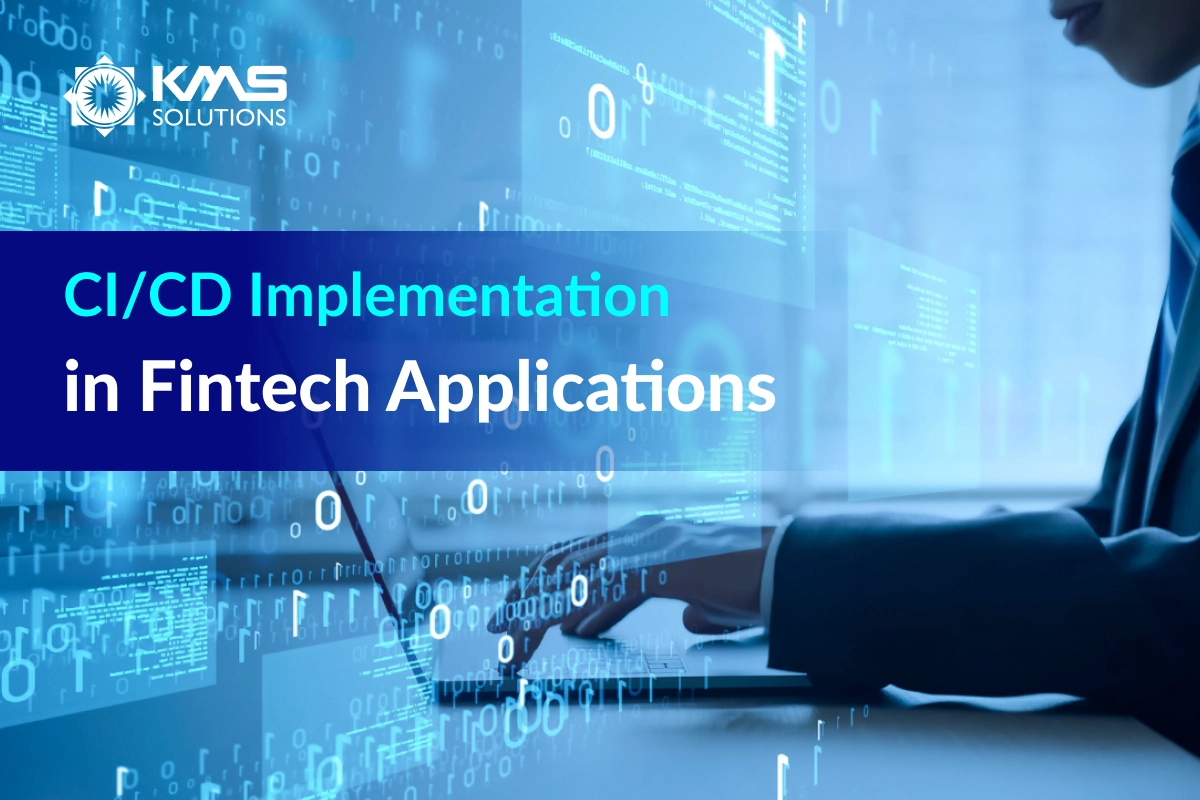The FinTech industry is undergoing rapid transformation, fueled by significant investments and the continuous emergence of innovative ideas. This dynamic environment brings a constant demand for new services, updates to existing ones, and accelerated development timelines. Speed has become an essential requirement for success in FinTech.
Amidst intense competition, companies face immense pressure to launch products ahead of their rivals. By adopting continuous integration and continuous delivery/deployment (CI/CD) practices, organizations can meet these demands effectively. CI/CD not only enhances the quality of products but also significantly reduces time-to-market, enabling businesses to stay competitive in this fast-paced industry.
In this article, we will discover the benefits that CI/CD can brings to Fintech software and key strategies for implementing this practice in financial services apps.
What is CI/CD in FinTech Apps?
Continuous Integration (CI) and Continuous Deployment (CD) are software development practices designed to streamline and accelerate the process of building, testing, and deploying applications. In the context of FinTech apps, CI/CD plays a critical role in meeting the industry’s high demands for speed, quality, security, and scalability.
- Continuous Integration (CI): is the practice of integrating code changes from multiple developers into a shared repository frequently, often multiple times a day. Each integration triggers an automated build and testing process to identify issues early in development.
- Continuous Deployment (CD): ensures that the codebase is always in a deployable state. Every update passes through rigorous automated testing and is delivered to staging or production environments seamlessly. Deployment can be manual but is made simple and risk-free due to automated processes.
Why is CI/CD Essential for Fintech Applications?
CI/CD are vital for Fintech apps due to the BFSI industry’s stringent requirements for reliability and security. The banking sector handles sensitive financial data and must meet high expectations for real-time performance and compliance with regulatory standards. Here’s why CI/CD is indispensable for Fintech apps:
- Accelerated Time-to-Market: CI/CD pipelines enable faster development and deployment cycles, allowing financial institutions to roll out new features and updates quickly. This speed is critical in a competitive market where customer demands and regulatory requirements change rapidly.
- Enhanced Quality Assurance: By automating testing at every stage of development, CI/CD helps ensure that Fintech software are reliable and free of bugs. This is crucial for maintaining customer trust and avoiding costly errors.
- Regulatory Compliance: Fintech apps must adhere to strict regulations like GDPR, PCI DSS, and Anti-money laundering (AML). CI/CD integrates automated compliance checks into the development process, ensuring that updates meet all legal and regulatory requirements.
- Increased Security: With Fintech apps being frequent targets for cyberattacks, CI/CD pipelines can incorporate continuous security testing and vulnerability scans to protect sensitive customer data and transaction details.
- Adaptability and Innovation: CI/CD allows banks to adopt emerging technologies like AI/ML, cybersecurities, RPA, etc. more efficiently, enabling them to innovate and offer cutting-edge solutions to their customers.
Challenges When Implementing CI/CD in Fintech App
While CI/CD is a powerful approach for boosting productivity and improving software quality, it comes with its own set of challenges that the BFSI organizations must address proactively:
- Shortage of Skilled Professionals: Implementing CI/CD requires a deep understanding of the processes and tools involved. Finding professionals with the necessary expertise can be particularly difficult for smaller businesses or organizations without a robust talent pipeline.
- High Initial Investments: Adopting CI/CD involves significant upfront costs, including integrating the technology into existing workflows and providing employee training. Without the right expertise, businesses risk delayed product releases, which can negate the benefits of CI/CD.
- Complex Maintenance Requirements: Successfully deploying CI/CD pipelines is only the first step; maintaining them is an ongoing challenge. For large and complex financial institutions, measuring throughput and optimizing cycle times across diverse teams and systems can be time-consuming and resource-intensive.
By acknowledging these challenges early, organizations can implement strategies to mitigate risks, ensuring a smoother transition to CI/CD practices and maximizing their long-term benefits. Moreover, they can also outsource to the digital team that has experience in the DevOps field, In KMS Solutions, we provide comprehensive DevOps services and collaboration CI/CD tools to test software mor effectively and streamline clients software delivery.
Key Stages of Adopting CI/CD for Financial Services
Implementing CI/CD in Fintech apps involves a systematic approach divided into three primary stages. These stages ensure that code changes are thoroughly tested, safe for deployment, and optimized for production use.
Here’s a comprehensive guide to enhancing BI capabilities in the banking and finance sector:
1. Review and Build Stage
The CI/CD process begins with a pull request (PR), where code changes are reviewed and validated. This stage is critical for ensuring the correctness and safety of the code before it progresses further. Key actions in this stage are:
- Testing the Code: Incorporating unit tests, integration tests, and end-to-end tests to verify functionality and performance.
- Monitoring Readiness: Ensuring metrics, logs, and traces are included for effective application monitoring.
- Impact Evaluation: Assessing the potential impact on production systems and planning rollback mechanisms.
- Automating Infrastructure Changes: Leveraging tools like Terraform to automate cloud infrastructure updates and declare dependencies efficiently.
This stage aims to establish a robust foundation for code quality and readiness.
2. Pre-Production Stage
During this phase, code artifacts are deployed to a controlled environment designed for testing. While not an exact replica of production, this synthetic environment helps identify and address potential issues before the final release. Best practices for this stage include:
- Smoke Testing: Running smoke tests in newly created environments to catch any immediate issues.
- Realistic Testing Scenarios: Using persistent pre-production environments that simulate real-world conditions.
- Aligned Metrics and Alerts: Ensuring that metrics, alerts, and tests in the pre-production environment mirror those in production for better coverage and reliability.
This stage serves as a final checkpoint to ensure the code is production-ready.
3. Production Stage
The final stage involves deploying the validated code to the production environment. To reduce risks, a phased approach is recommended for the release. Key steps in this stage:
- Initial Deployment: Rolling out the update to a limited number of production instances to monitor for issues.
- Low-Traffic Regions: Starting with low-traffic regions for multi-region services to minimize potential disruptions.
- Sequential Rollouts: Gradually releasing to additional regions as confidence in the deployment grows.
As the deployment progresses successfully, the release speed can be increased, reducing downtime and ensuring a seamless transition to the new version.
Tips to Ensure CI/CD Security in Financial Services
Implementing CI/CD pipelines in financial services brings efficiency and agility but also requires robust security measures to safeguard sensitive data and maintain compliance with regulatory standards. Below are essential tips to secure CI/CD pipelines in the financial sector:
1. Incorporate Security Early (Shift Left)
Integrate security testing at the earliest stages of the CI/CD process to identify vulnerabilities before deployment. This proactive approach minimizes risks and saves costs associated with fixing issues later.
- Use security testing to scan code for vulnerabilities.
- Perform regular dependency checks for third-party libraries and frameworks.
2. Automate Security Testing
Embed automated security tests into the CI/CD pipeline to ensure consistent and comprehensive assessments without slowing down the process.
- Use tools for security testing to evaluate runtime vulnerabilities.
- Employ Infrastructure as Code (IaC) scanning tools to detect misconfigurations in cloud deployments.
3. Comply with Industry Standards
Ensure CI/CD practices align with the BFSI industry regulations and standards such as GDPR, PCI DSS, or SOC 2.
- Implement compliance checks as part of the pipeline.
- Maintain an audit trail of all activities for reporting and accountability.
CI/CD in BFSI Industry Examples
Example 1: Faster Deployment of New Banking Features
Capital One utilizes CI/CD pipelines to streamline the release of new features for their mobile banking app. For example, they might roll out a new feature like real-time fraud alerts. Using CI/CD, the feature can be developed, tested, and deployed in smaller, incremental releases, allowing Capital One to gather user feedback and quickly make adjustments.
This agile approach allows Capital One to continuously improve their mobile app based on real-time customer feedback while ensuring minimal downtime and faster time-to-market.
Example 2: Continuous Integration for Core Banking Systems
ING has adopted CI/CD to streamline the integration of core banking systems with new software solutions. This includes integrating fintech innovations such as robo-advisors or AI-driven credit scoring systems into the existing banking infrastructure. Continuous integration ensures that any new software can be merged into the core system without causing downtime or issues.
ING benefits from reduced integration time, better testing coverage, and the ability to integrate fintech innovations without disrupting their core banking services.
Conclusion
Implementing CI/CD in fintech applications is no longer a choice—it’s a necessity to keep pace with the industry’s rapid innovation and growing customer expectations. By adopting the right strategies, financial insitutions can enhance their agility, reduce time-to-market, and deliver high-quality, reliable software.
To help BFSI businesses navigate the challenges with Ci/CD implementation, KMS Solutions, with years of expertise in software development and technology consulting, can provide end-to-end support for businesses aiming to adopt CI/CD. From evaluating your current processes and creating a customized CI/CD roadmap to implementing cutting-edge tools and practices, KMS ensures a seamless transition.











